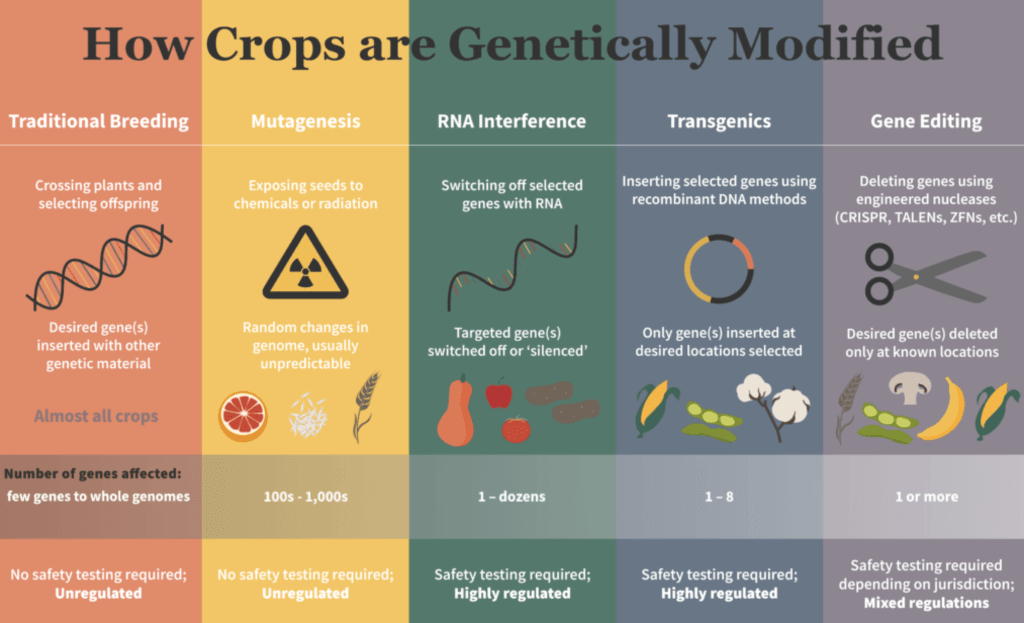The United Nations Cartagena Protocol on Biosafety an international agreement (which the US has not signed) designed to ensure the safe handling, transportation and use of genetically engineered crops in 1996 used the term LMO instead of GMO:
A Living Modified Organism (LMO) is defined as any living organism that possesses a novel combination of genetic material obtained through the use of modern biotechnology. In everyday usage LMOs are usually considered to be the same as GMOs, but definitions and interpretations of the term GMO vary widely.
The Pew Initiative on Food and Biotechnology, 2001, did not define the acronym GMO but defined biotechnology as:
“…the use of recombinant DNA technology to transfer genetic material from one organism to another.” The resulting organism is referred to as transgenic.
The European Food Safety Authority (EFSA) has adopted this one:
The term genetically modified organism (GMO) means an organism in which the genetic material has been altered in a way that does not occur naturally through fertilisation and/or natural recombination. GMOs may be plants, animals or micro-organisms, such as bacteria, parasites and fungi.
Drawing on those definitions, the US law defines a GMO not as any crop in which the genetic material has changed over time, but when a food “contains genetic material that has been modified through in vitro recombinant deoxyribonucleic acid (DNA) techniques; and for which the modification could not otherwise be obtained through conventional breeding or found in nature.” Older techniques and also anything modified with the newest gene-editing techniques are exempt. In short, GMO is lingua franca for transgenic via rDNA.
There are numerous problems with these definitions, not the least of which is that we now know that all organisms (including humans) are natural transgenics–the genetic product of combining genetic material from different species. The classic definitions also include techniques that have been utilized in agriculture for decades pre-dating the introduction of the first genetically engineered crops in the 1990s. They imply that all GMOs must be made “in a laboratory,” which is untrue. They also imply that only GMOs are altered “in a laboratory,” which is not accurate, and that laboratory breeding is somehow unnatural, which if true would mean that many modern versions of foods are unnatural. For example, nematode resistant tomatoes were first generated in the 1940s using a plant breeding technique called embryo rescue “in a lab” with genes from a wild plant species—half a century before rDNA. Embryo rescue, cell fusion, chemical/physical mutagenesis and a lot of other techniques are “unnaturally” performed “in the lab” but are not classified as GMOs. Much of the attention given to GMOs has focused on plants or animals in which genetic material from unrelated species are joined the use of so-called foreign genes. Such transgenic pairings have resulted in products, including soybeans, corn and cotton, that are resistant to certain herbicides. However, this phenomenon also occurs in nature, albeit on a more limited basis. The sweet potato, for example, is a result of nature’s own transgenic breeding. But it’s not the only one. A 2019 study revealed that 39 plant species qualify as natural GMOs. And since at least the 1930s, plant breeders have performed “wide cross” hybridizations, in which large numbers of “foreign” genes have been moved across what used to be thought of as “natural breeding boundaries” to create plant varieties that cannot and do not exist in nature. As geneticist Henry Miller has noted,
Most of these hybridizations, which are performed between organisms of different species or genera, produce a non-viable zygote, so laboratory scientists devised mechanical and biochemical ways to “rescue” the embryos and enable them to develop. Common commercial crops derived from wide crosses include tomato, potato, sweet potato, oat, rice, wheat, corn, and pumpkin, among others.
The main problem with the widely-circulated definitions of GMO is that they perpetuate the GMO=unnatural and unnatural=GMO misconception–a framing popular with agricultural biotechnology critics. As Grist‘s Nathanael Johnson has written, current popular definitions of GMOs do not hold up under scientific scrutiny. There is no clear definition, he concluded, calling it a ‘social construct’ that has come to represent larger social and environmental concerns.
People argue about GMOs because they are worried about safety, or environmental integrity, or human rights. Like porn, GMOs defy strict definition because, like porn, GMOs are a cultural construct with borders that shift with the times. Perhaps the most accurate definition of GMO is social and contextual: Organisms breed in a way that people find threatening.
GMO ambiguities abound in other ways. In crop biotechnology, while the seed is genetically modified, in some cases the final product is identical to the non-GMO variety, rendering the term problematic. There is no genetic difference, for example, between GMO and non-GMO sweet corn, sugar made from GMO sugar beets versus non-GMO cane sugar or oils made from GMO soybeans, which are processed (e.g. syrup, oil, starch from maize or sugar from sugar beet do not contain DNA.)
Many food additives rely on genetically modified fungi or bacteria, but are not considered GMOs. Most hard cheeses use a GM enzyme, which the non-GMO Project says qualifies them as GMOs, but Vermont’s labeling law did not. GM microorganisms are used to make many vitamins, often used to fortify products; the Non-GMO Project considers them GMOs, but European regulators and most labeling laws do not.
Janet Carter, a soil scientist and longtime consultant to Greenpeace on its anti-GMO efforts, writing for GMWatch, has challenged Johnson’s view that there is no such thing as a GMO.
It’s important here to differentiate between novel combinations of genetic material that happen occasionally or rarely in nature, and the routine production of organisms with novel combinations of genetic material that are produced with genetic engineering.
Carter rejects mutagenesis, in which plants are altered in laboratories using chemicals or radiation as an example of a GMO, contending it is “random” and not “directed.” As do many anti-GMO activists, she contends that a “GMO is not defined by the presence of ‘foreign genes’ positioning biotech critics to oppose new breeding technologies (NBTs), which do not necessarily involve transgenics. Many critics of crop biotechnology are concerned that CRISPR and other NBTs will escape the restrictive regulations that have stifled modern crop innovations.
The United States does not employ a specific legal definition of a GMO. It uses a patchwork of regulations and oversight by the Department of Agriculture, Food and Drug Administration and Environmental Protection Agency to address the subject. The focus is on the products themselves (and whether they are safe), rather than the way in which they were made. According to the FDA:
“Genetic engineering generally refers to the use of recombinant DNA (rDNA) techniques to introduce new characteristics or traits into an organism.”
Under this definition, the USDA has chosen not to regulate gene-edited crops as GMOs.



